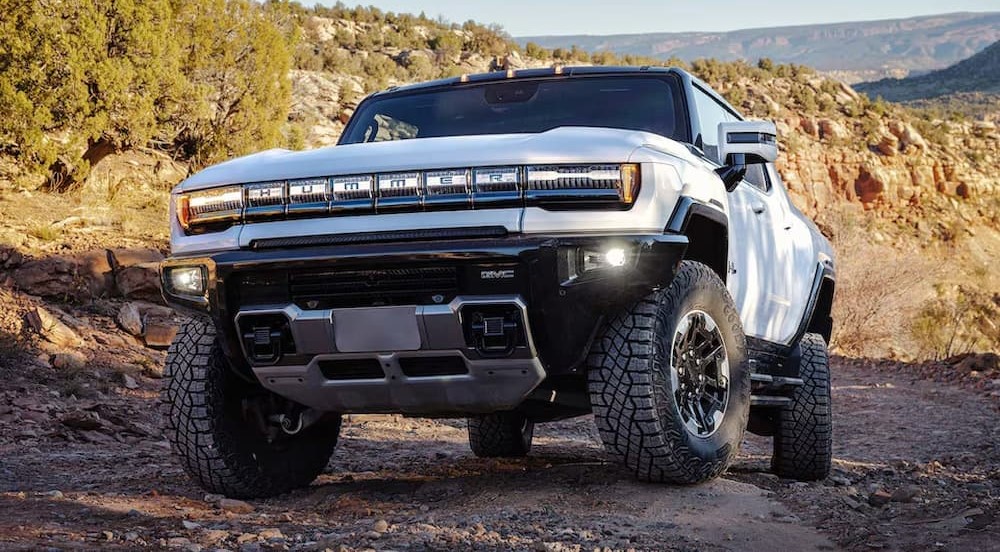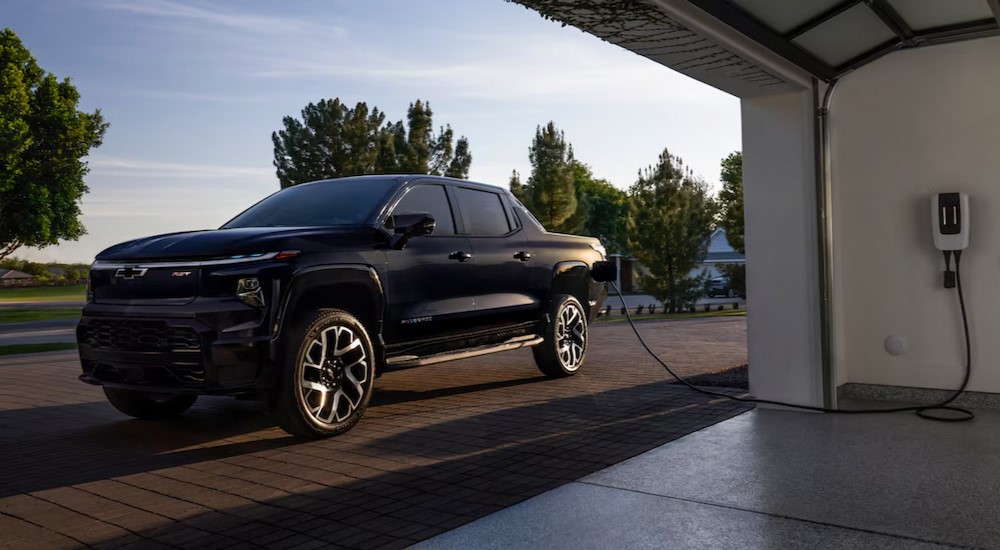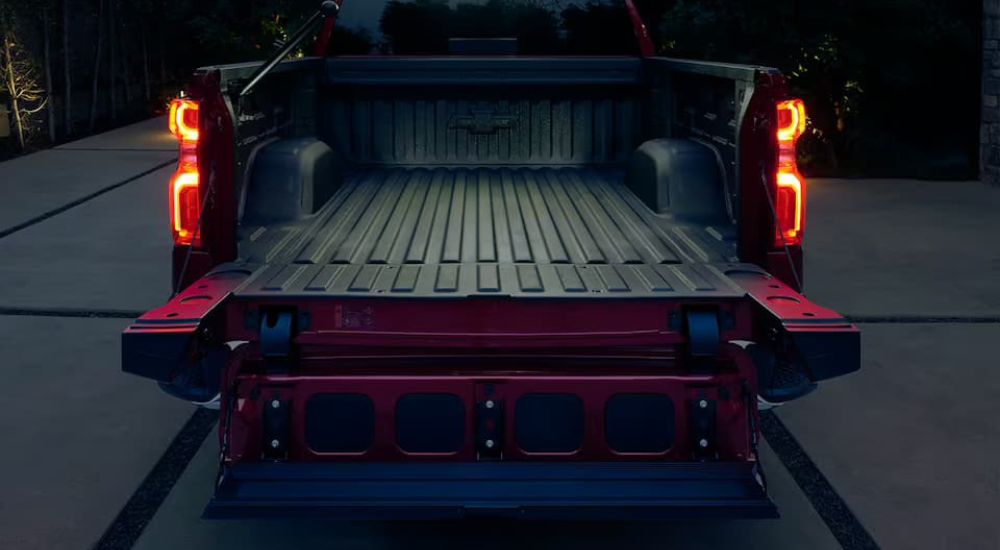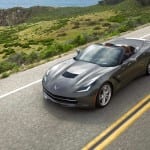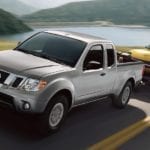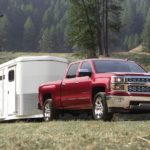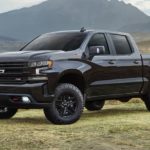In recent years, few auto segments have seen quite as much innovation as the pickup truck. Once a no-nonsense vehicle aimed at the needs of farmers, tradesmen, and the like, today’s pickups are now among the most luxurious, stylish, and tech-heavy rides on the road. From electrifying new EVs like the Ford F-150 Lightning to veritable super trucks and high-performance models like the Ram 1500 TRX to heavy-duty models like the Chevy Silverado 3500 that can virtually move mountains, the modern pickup segment offers a wide range of choices and features that are sure to meet the unique needs of every driver.
There are a few of these features—like four-wheel drive, extended cabs and integrated trailer brake controllers—that have become standard fare across the pickup segment, but then there are the cutting-edge offerings that are limited to certain makes and models. Vehicle to Home (V2H) charging systems and advanced four-wheel wheel drive systems that allow trucks to move in some unexpected ways are unique to EV pickups, while certain off-road features, trailing tech, and storage solutions can only be found on select models from Ford, GM, and Ram.
Drivers have some tough choices to make when it comes to prioritizing those features that are most important to their driving journey, but what if we didn’t have to choose? In that spirit of indecision, I’ve compiled a short list of the five best features on the market that I wish we could find on one truck. Join me as I review some of the most enticing pickup tech on the market and build the pickup of our dreams…
Backup Power
The new generation of all-electric pickups opens the door to some pretty cool automotive tricks. From regenerative braking and individually powered wheels to one-pedal driving and front trunks that double as mobile coolers, the EV approach introduces plenty of fun, innovative features into the mix. While each is worth its own write-up, there’s one feature that has the potential to transform your home just as much as these EVs have transformed the drive: Bidirectional charging, also known as Vehicle to Home (V2H) charging, allows your truck to act as a backup generator capable of powering everything from tools and appliances to your entire house.
These V2H systems go by a variety of names based on the manufacturer, but they all accomplish the same basic goal: serving as a vital lifeline when power outages strike. They also differ in terms of performance. Take the Ford F-150 Lightning, for example. When paired with the Ford Intelligent Backup Power system, the EV can provide a home with 9.6kW of power for three days (or up to ten days with proper rationing). The Silverado EV ups the ante with a massive 200-kWh battery that can put out 10.2kW for almost three weeks, though this feature is currently limited to the range-topping RST trim.
Of course, there is a catch: These V2H systems are offered as optional extras and require a significant monetary investment. Turning the Silverado EV into a full-fledged home generator requires drivers to purchase both the GM Energy Powershift Charger at a cost of $1,699 as well as the $5,600 GM Energy V2H Enablement Kit, and that doesn’t include taxes or installation costs. The F-150 Lightning is no different, with owners needing to install the Charge Station Pro in order to get access to the truck’s backup power capabilities. It might be a little pricey, but both systems are still cheaper than the average home battery backup system which can typically run between $10,000 and $20,000.
Electronic 4-Wheel Steer
Four-wheel drive is an essential feature in the eyes of most pickup drivers, but not all 4WD systems are created equal. The Hummer EV Pickup’s Electronic 4-Wheel Steer system is a great example. The all-electric pickup is designed with a unique 4WD system that not only offers all the traction-enhancing functionality of a traditional 4×4 but also lets the front and rear wheels point in opposite directions in order to increase maneuverability.
Available whenever the Hummer EV Pickup is moving at speeds of less than 25 mph, Electronic 4-Wheel Steer can make all the difference when trying to navigate a tight corner or maximize traction. When it’s set to Automatic Mode, the 4WD system enables the rear wheels to adjust by as much as ten degrees, creating a tighter turning radius that’ll come in handy for off-road applications. When the truck’s speed exceeds 25 mph, the rear wheels move in sync with the front wheels to improve stability and safety, giving drivers the chance to enjoy the best of both worlds while making the Hummer EV Pickup a standout in the hotly contested segment.
Electronic 4-Wheel Steer is an impressive feature in its own right, but GMC has taken the idea one step further with the addition of Crab Walk Mode. While Automatic Mode is focused on maneuvering the rear wheels, Crab Walk Mode lets all four wheels move in the same direction for maximum maneuverability. Crab Walk Mode doesn’t allow the truck to move laterally like its crustacean namesake, but it does let the Hummer EV Pickup drive diagonally at speeds of less than 1.2 mph.
This feature is sure to come in handy in both on- and off-road applications, whether you’re trying to pilot through a particularly narrow pass or slide into the last remaining parallel parking spot on your block. Rivian had teased a similar Tank Turn feature on the R1T that would allow this EV to leverage its quad-motor setup to turn in a perfect circle, but they nixed the technology after some raised concerns that it could compromise the terrain of off-road trails.
Trailer Backup Assist
Backing into a spot when you’re towing a trailer, RV, or boat can be one of the most frustrating tasks any driver will encounter. This unique skill requires some mirror-like thinking that can be tough to master. In a traditional truck, turning the steering wheel to the left will cause the trailer to move to the right, whereas moving it to the right will have the trailer veer to the right. It can be a lot to wrap your mind around, especially if you’re dealing with a cab full of cranky kids or a crowded boat launch on a weekend afternoon.
The technique is easy enough to master with enough practice, but why struggle to get the perfect fit when you have a feature like Ford’s Pro Trailer Backup Assist or the Ram 1500’s Trailer Reverse Steering Control? Available on select models and trims, these features take all the guesswork out of reversing your trailer with a simple knob-based control. Just put the truck into reverse, activate the Trailer Backup Assist or Trailer Reverse Steering Control feature, and you simply have to turn a small, dash-mounted dial to precisely steer your cargo into place.
The driver is still responsible for controlling the accelerator and brake pedal, but the trailer backup assist systems handle everything else, allowing you to squeeze into the tightest of spaces with ease by turning the knob to the left or right. Drivers can monitor their progress on the infotainment display, where a rear-mounted camera offers a comprehensive view of their surroundings. Some pickup purists might scoff at the simplicity of such a system, but they’ll still be endlessly adjusting their load and swearing under their breath while you’re busy making waves out on the lake.
Multi-Pro Tailgate
The humble tailgate has become the site of a new arms race in the pickup world. With every passing model year, brands are introducing new tailgate designs that boast a long list of work-ready features designed to enhance utility and convenience. This innovation has largely been focused on the ways in which the tailgate can be opened.
The Honda Ridgeline was one of the first to embrace a design that allowed the tailgate to either fold down or swing open, and Ram improved on the technology with two folding or swing-out doors that could be partitioned in a 60/40 split. The 2024 Ford F-150 tweaked this approach with a three-way split that allows the middle 60% of the tailgate to swing open on its own, but if you’re seeking top-tier innovation, look no further than the GMC MultiPro tailgate and the Chevy Multi-Flex tailgate.
Originally debuting on the 2019 GMC Sierra, this inventive design sees the tailgate morph into six different shapes. The tailgate can be deployed in the traditional fold-down method or use a panel flipped up from the inner gate to act as a load stop. With the inner gate folded down, drivers can reach deeper into the cargo bed to allow for easier loading—but it’s not the only accessibility-related feature found on the MultiPro tailgate.
Need a little boost? With the inner gate folded down and the inner panel flipped up, drivers will gain access to a handy step that’ll make for easier entry into the cargo bed. The tailgate boasts a second, higher load stop feature, but it’s the MultiPro’s ability to double as a work surface or impromptu lunch counter that really sets the design apart. Whether you’re trying to reduce the wear and tear on your knees or looking for a place to review blueprints, catch up on paperwork, or enjoy a little lunch, the MultiPro tailgate is designed with the working man in mind.
Crawl Control
Off-roading presents some unique challenges, whether you’re dodging rocks and logs, fording streams, clawing through the mud, or ascending steep hills. These challenges are half the fun of any off-road excursion, but that certainly doesn’t mean a little help isn’t appreciated from time to time. Toyota’s Crawl Control feature is designed to help drivers conquer tough off-road terrain while traveling at lower speeds. This system essentially takes over all acceleration and braking duties, giving drivers the opportunity to focus their attention on steering around any obstacles, avoiding encroaching trees, and staying clear of steep edges.
Crawl Control comes paired with Toyota’s Multi-Terrain Select software, which includes specific modes ranging from Mud/Sand, Loose Rock, and Rock/Dirt to Mogul and Rock. Available whenever the truck is in 4-Lo mode, Crawl Control is activated using either a roof- or dash-mounted button. The system includes five distinct settings that can be used to tackle a variety of grades and terrains; when you’re facing a particularly steep hill, the lowest setting keeps the speed limited to 1 mph to allow you enough time to maneuver around rocks, moguls, and other obstacles.
The system can also be adjusted to between 2 and 5 mph, with the speedier settings giving drivers the opportunity to master snow, mud, sand, and other loose surfaces. Toyota’s Crawl Control feature can also be used when the truck is moving in reverse, which should come in handy when trying to remove yourself from a sticky situation or take another run at a particularly steep hill. Ford fans will be happy to hear that the Big Blue Oval offers its own Crawl Control-like system in the form of Ford Trail Control, and other brands are sure to follow suit.
Co-Opting Great Ideas Into One Imaginative Pickup
If you’re looking to build the pickup of your dreams and don’t want to wait for the market to catch up with your expectations, you can always opt to create a custom ride using the build and price customization approach employed by almost all of today’s automakers. Various trims and packages serve as a good starting point, but these handy online platforms allow drivers to personalize everything from the exterior paint color and sound systems to the cab size, bed length, engine, transmission, and more.
It might be tough to find a current pickup that’s packing all the gear listed above, but it’s probably only a matter of time until these features become standard—or at least a little more common—across a wide range of models. The EV segment, in particular, holds some real promise, with all-electric powertrains opening the door to some neat tricks in terms of four-wheel drive, V2H features, and towing strength. With automakers steadily adopting electrification across their lineups, we expect all-electric pickups to become a major force to be reckoned with in the segment. There are simply too many advantages to ignore, from the obvious environmental benefits to the sort of instant power and acceleration these trucks can provide.
